TOYOTA YARIS HYBRID 2015 Owners Manual
Manufacturer: TOYOTA, Model Year: 2015, Model line: YARIS HYBRID, Model: TOYOTA YARIS HYBRID 2015Pages: 492, PDF Size: 21.93 MB
Page 221 of 492
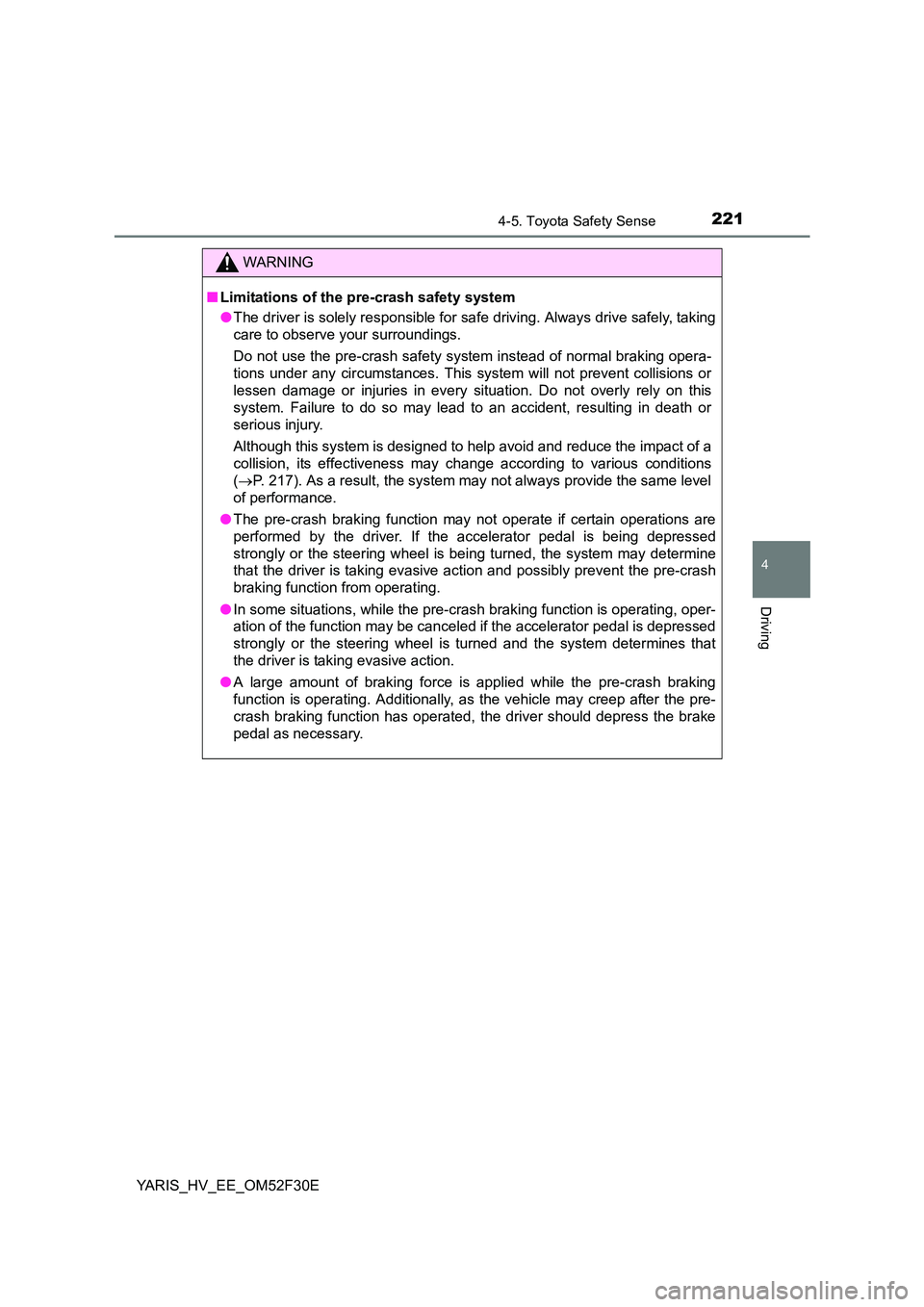
2214-5. Toyota Safety Sense
4
Driving
YARIS_HV_EE_OM52F30E
WARNING
■ Limitations of the pre-crash safety system
● The driver is solely responsible for safe driving. Always drive safely, taking
care to observe your surroundings.
Do not use the pre-crash safety sy stem instead of normal braking opera-
tions under any circumstances. This system will not prevent collisions or
lessen damage or injuries in every situation. Do not overly rely on this
system. Failure to do so may lead to an accident, resulting in death or
serious injury.
Although this system is designed to help avoid and reduce the impact of a
collision, its effectiveness may change according to various conditions
( →P. 217). As a result, the system may not always provide the same level
of performance.
● The pre-crash braking function may not operate if certain operations are
performed by the driver. If the accelerator pedal is being depressed
strongly or the steering wheel is bei ng turned, the system may determine
that the driver is taking evasive action and possibly prevent the pre-crash
braking function from operating.
● In some situations, while the pre-crash braking function is operating, oper-
ation of the function may be canceled if the accelerator pedal is depressed
strongly or the steering wheel is turned and the system determines that
the driver is taking evasive action.
● A large amount of braking force is applied while the pre-crash braking
function is operating. Additionally, as the vehicle may creep after the pre-
crash braking function has operated, the driver should depress the brake
pedal as necessary.
Page 222 of 492
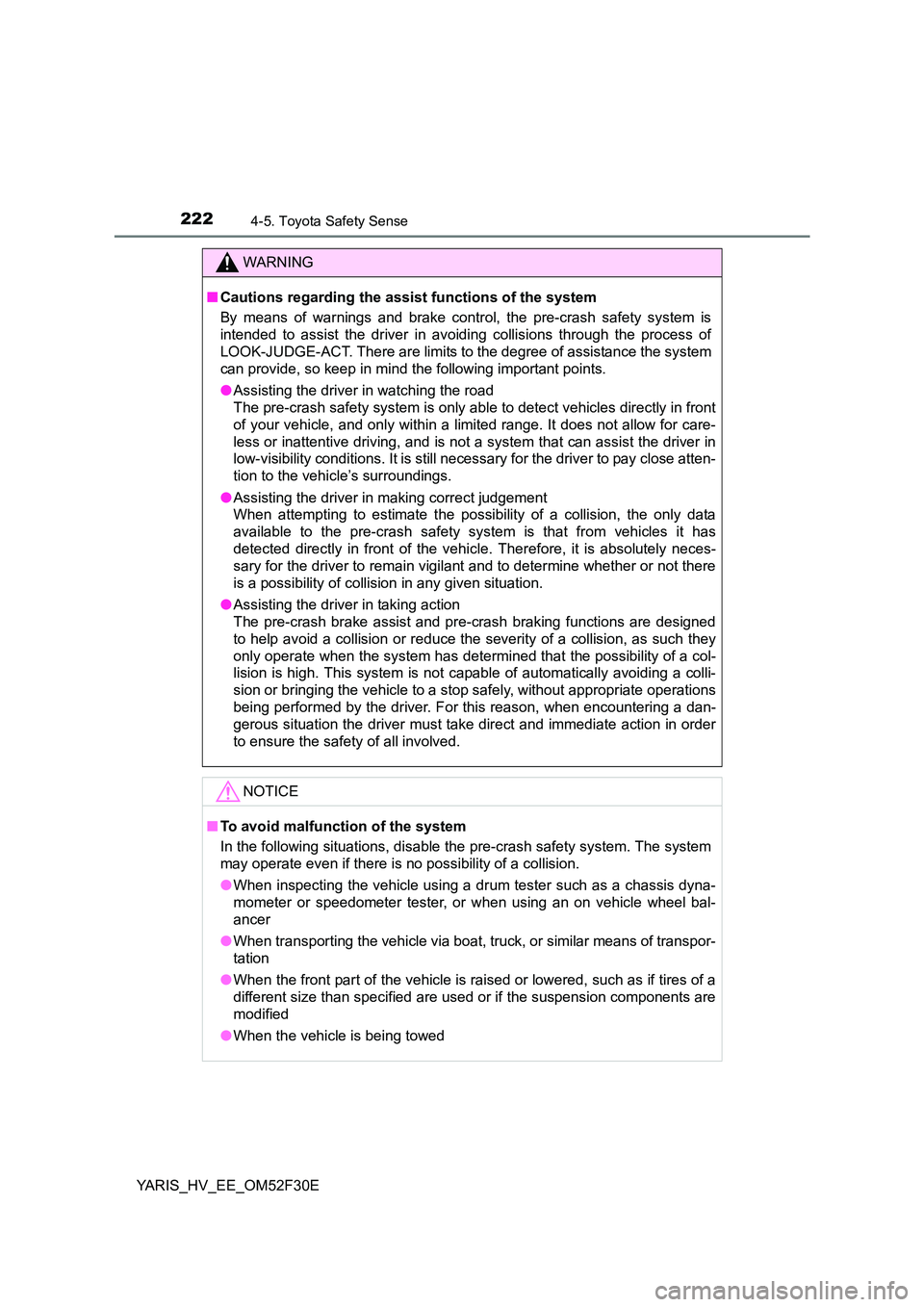
2224-5. Toyota Safety Sense
YARIS_HV_EE_OM52F30E
WARNING
■ Cautions regarding the assist functions of the system
By means of warnings and brake control, the pre-crash safety system is
intended to assist the driver in avoiding collisions through the process of
LOOK-JUDGE-ACT. There are limits to the degree of assistance the system
can provide, so keep in mind the following important points.
● Assisting the driver in watching the road
The pre-crash safety system is only able to detect vehicles directly in front
of your vehicle, and only within a limi ted range. It does not allow for care-
less or inattentive driving, and is not a system that can assist the driver in
low-visibility conditions. It is still necessary for the driver to pay close atten-
tion to the vehicle’s surroundings.
● Assisting the driver in making correct judgement
When attempting to estimate the possibility of a collision, the only data
available to the pre-crash safety system is that from vehicles it has
detected directly in front of the vehicle. Therefore, it is absolutely neces-
sary for the driver to remain vigila nt and to determine whether or not there
is a possibility of collision in any given situation.
● Assisting the driver in taking action
The pre-crash brake assist and pre- crash braking functions are designed
to help avoid a collision or reduce the severity of a collision, as such they
only operate when the system has determined that the possibility of a col-
lision is high. This system is not capable of automatically avoiding a colli-
sion or bringing the vehicle to a stop safely, without appropriate operations
being performed by the driver. For this reason, when encountering a dan-
gerous situation the driver must take direct and immediate action in order
to ensure the safety of all involved.
NOTICE
■ To avoid malfunction of the system
In the following situations, disable the pre-crash safety system. The system
may operate even if there is no possibility of a collision.
● When inspecting the vehicle using a drum tester such as a chassis dyna-
mometer or speedometer tester, or when using an on vehicle wheel bal-
ancer
● When transporting the vehicle via boat, truck, or similar means of transpor-
tation
● When the front part of the vehicle is raised or lowered, such as if tires of a
different size than specified are used or if the suspension components are
modified
● When the vehicle is being towed
Page 223 of 492
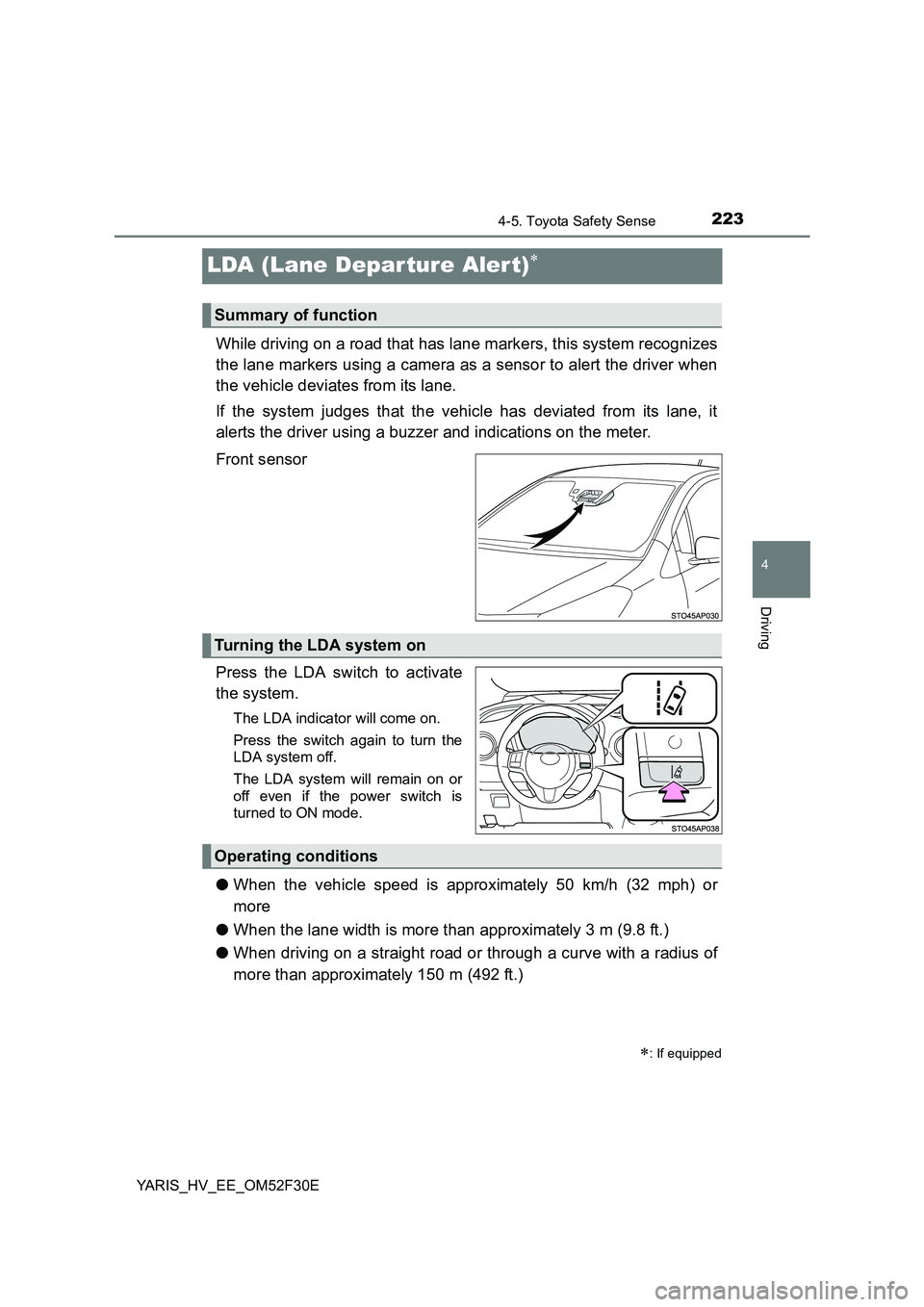
223
4
4-5. Toyota Safety Sense
Driving
YARIS_HV_EE_OM52F30E
LDA (Lane Depar ture Alert)∗
While driving on a road that has lane markers, this system recognizes
the lane markers using a camera as a sensor to alert the driver when
the vehicle deviates from its lane.
If the system judges that the vehicle has deviated from its lane, it
alerts the driver using a buzzer and indications on the meter.
Front sensor
Press the LDA switch to activate
the system.
The LDA indicator will come on.
Press the switch again to turn the
LDA system off.
The LDA system will remain on or
off even if the power switch is
turned to ON mode.
● When the vehicle speed is approximately 50 km/h (32 mph) or
more
● When the lane width is more than approximately 3 m (9.8 ft.)
● When driving on a straight road or through a curve with a radius of
more than approximately 150 m (492 ft.)
∗: If equipped
Summary of function
Turning the LDA system on
Operating conditions
Page 224 of 492
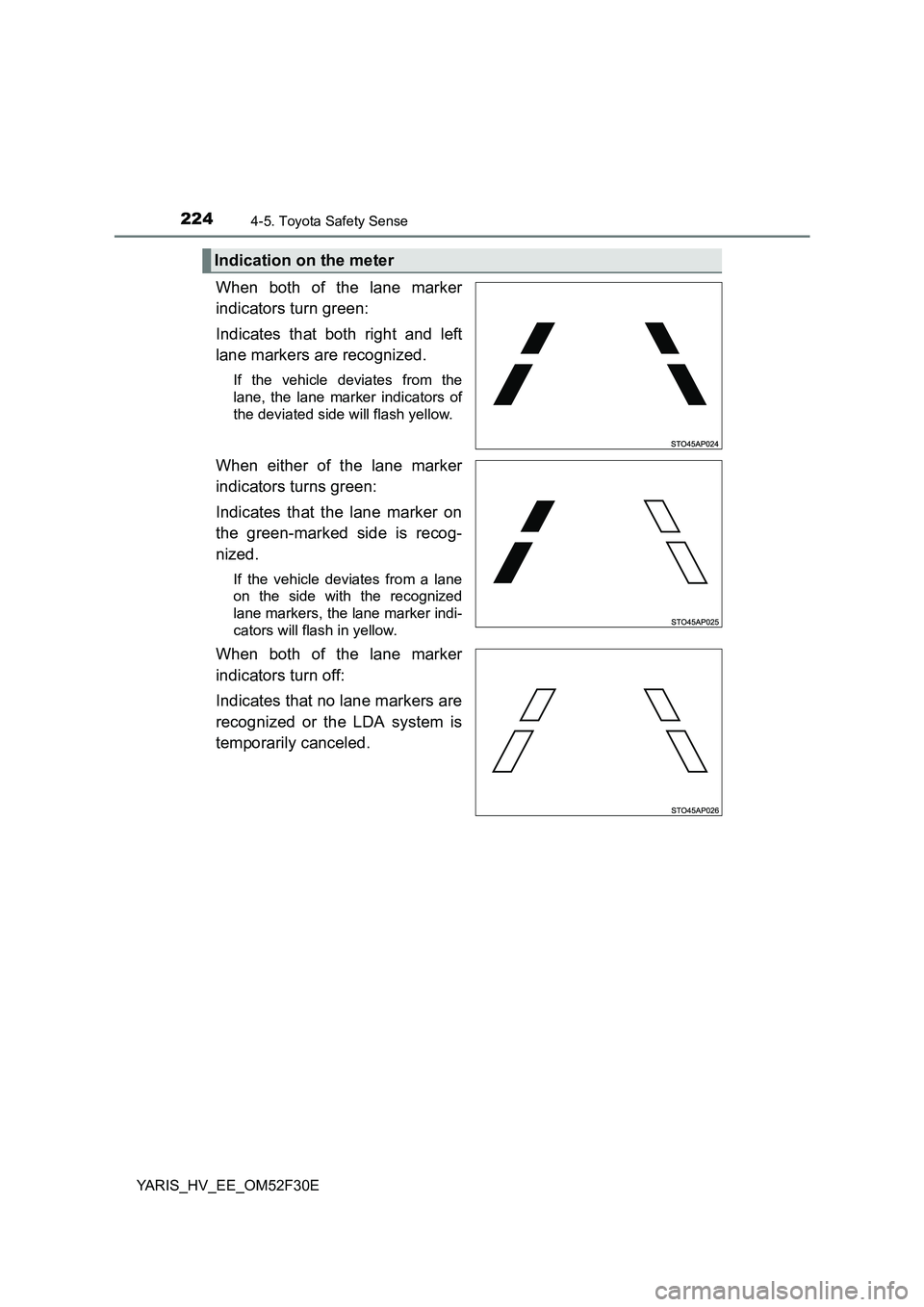
2244-5. Toyota Safety Sense
YARIS_HV_EE_OM52F30E
When both of the lane marker
indicators turn green:
Indicates that both right and left
lane markers are recognized.
If the vehicle deviates from the
lane, the lane marker indicators of
the deviated side will flash yellow.
When either of the lane marker
indicators turns green:
Indicates that the lane marker on
the green-marked side is recog-
nized.
If the vehicle deviates from a lane
on the side with the recognized
lane markers, the lane marker indi-
cators will flash in yellow.
When both of the lane marker
indicators turn off:
Indicates that no lane markers are
recognized or the LDA system is
temporarily canceled.
Indication on the meter
Page 225 of 492
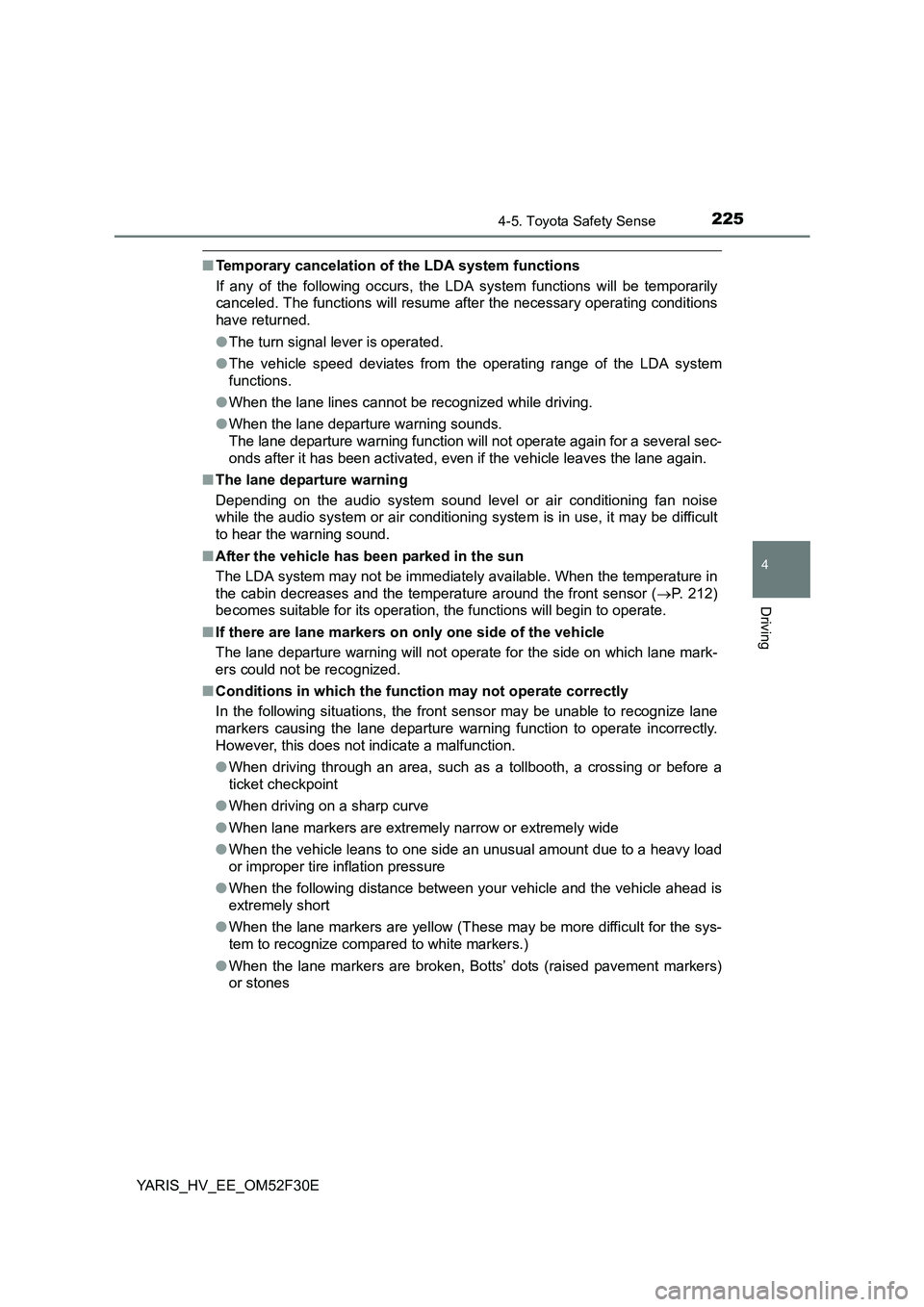
2254-5. Toyota Safety Sense
4
Driving
YARIS_HV_EE_OM52F30E
■Temporary cancelation of the LDA system functions
If any of the following occurs, the LDA system functions will be temporarily
canceled. The functions will resume after the necessary operating conditions
have returned.
● The turn signal lever is operated.
● The vehicle speed deviates from the operating range of the LDA system
functions.
● When the lane lines cannot be recognized while driving.
● When the lane departure warning sounds.
The lane departure warning function will not operate again for a several sec-
onds after it has been activated, even if the vehicle leaves the lane again.
■ The lane departure warning
Depending on the audio system sound level or air conditioning fan noise
while the audio system or air conditioning sy stem is in use, it may be difficult
to hear the warning sound.
■ After the vehicle has been parked in the sun
The LDA system may not be immediatel y available. When the temperature in
the cabin decreases and the temperature around the front sensor ( →P. 212)
becomes suitable for its operation, the functions will begin to operate.
■ If there are lane markers on only one side of the vehicle
The lane departure warning will not operate for the side on which lane mark-
ers could not be recognized.
■ Conditions in which the function may not operate correctly
In the following situations, the front sensor may be unable to recognize lane
markers causing the lane departure warning function to operate incorrectly.
However, this does not indicate a malfunction.
● When driving through an area, such as a tollbooth, a crossing or before a
ticket checkpoint
● When driving on a sharp curve
● When lane markers are extremely narrow or extremely wide
● When the vehicle leans to one side an unusual amount due to a heavy load
or improper tire inflation pressure
● When the following distance between your vehicle and the vehicle ahead is
extremely short
● When the lane markers are yellow (These may be more difficult for the sys-
tem to recognize compared to white markers.)
● When the lane markers are broken, Botts’ dots (raised pavement markers)
or stones
Page 226 of 492
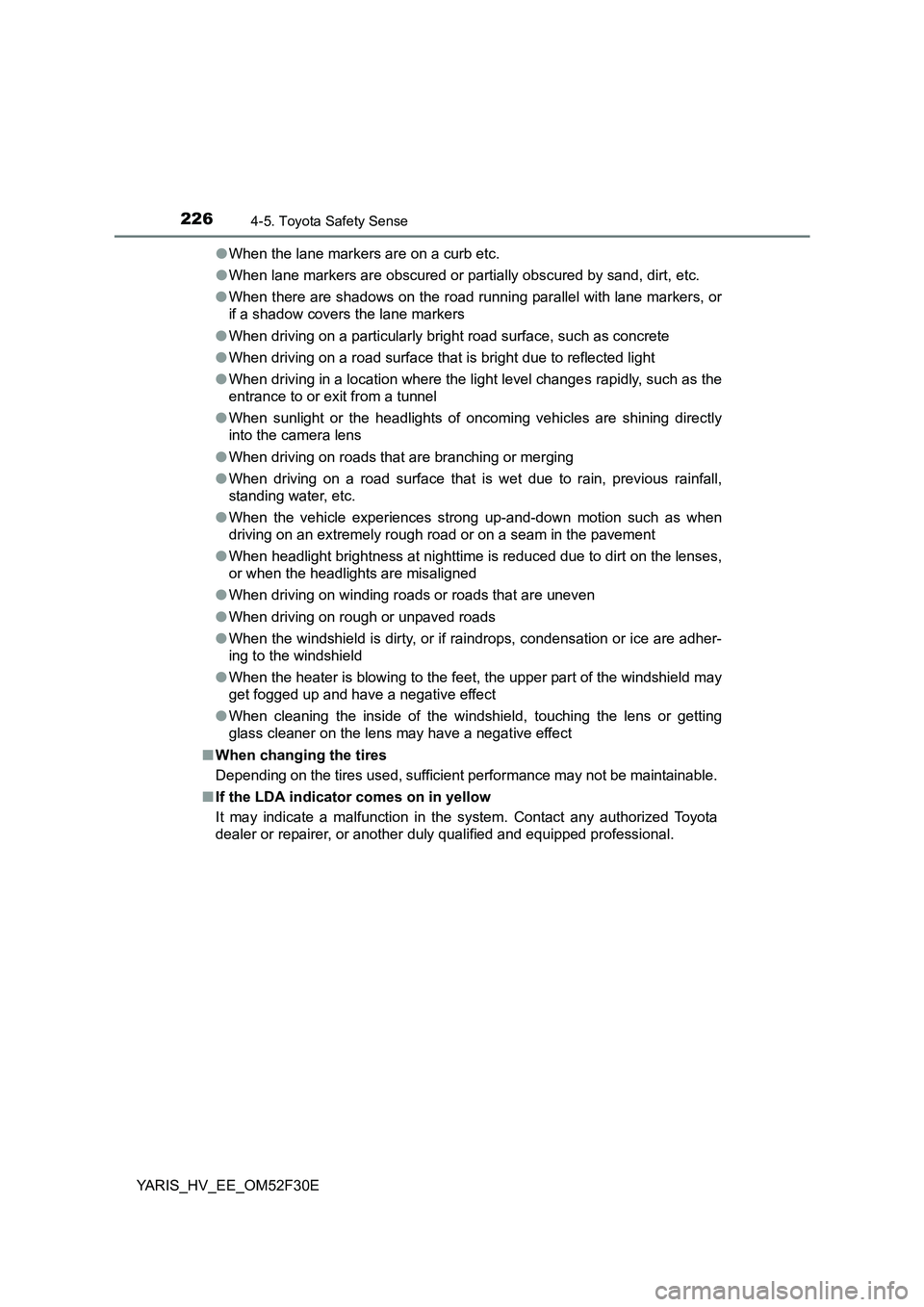
2264-5. Toyota Safety Sense
YARIS_HV_EE_OM52F30E
● When the lane markers are on a curb etc.
● When lane markers are obscured or partially obscured by sand, dirt, etc.
● When there are shadows on the road running parallel with lane markers, or
if a shadow covers the lane markers
● When driving on a particularly bright road surface, such as concrete
● When driving on a road surface that is bright due to reflected light
● When driving in a location where the light level changes rapidly, such as the
entrance to or exit from a tunnel
● When sunlight or the headlights of oncoming vehicles are shining directly
into the camera lens
● When driving on roads that are branching or merging
● When driving on a road surface that is wet due to rain, previous rainfall,
standing water, etc.
● When the vehicle experiences strong up-and-down motion such as when
driving on an extremely rough road or on a seam in the pavement
● When headlight brightness at nighttime is reduced due to dirt on the lenses,
or when the headlights are misaligned
● When driving on winding roads or roads that are uneven
● When driving on rough or unpaved roads
● When the windshield is dirty, or if raindrops, condensation or ice are adher-
ing to the windshield
● When the heater is blowing to the feet, the upper part of the windshield may
get fogged up and have a negative effect
● When cleaning the inside of the windshield, touching the lens or getting
glass cleaner on the lens may have a negative effect
■ When changing the tires
Depending on the tires used, sufficient performance may not be maintainable.
■ If the LDA indicator comes on in yellow
It may indicate a malfunction in the system. Contact any authorized Toyota
dealer or repairer, or another duly qualified and equipped professional.
Page 227 of 492
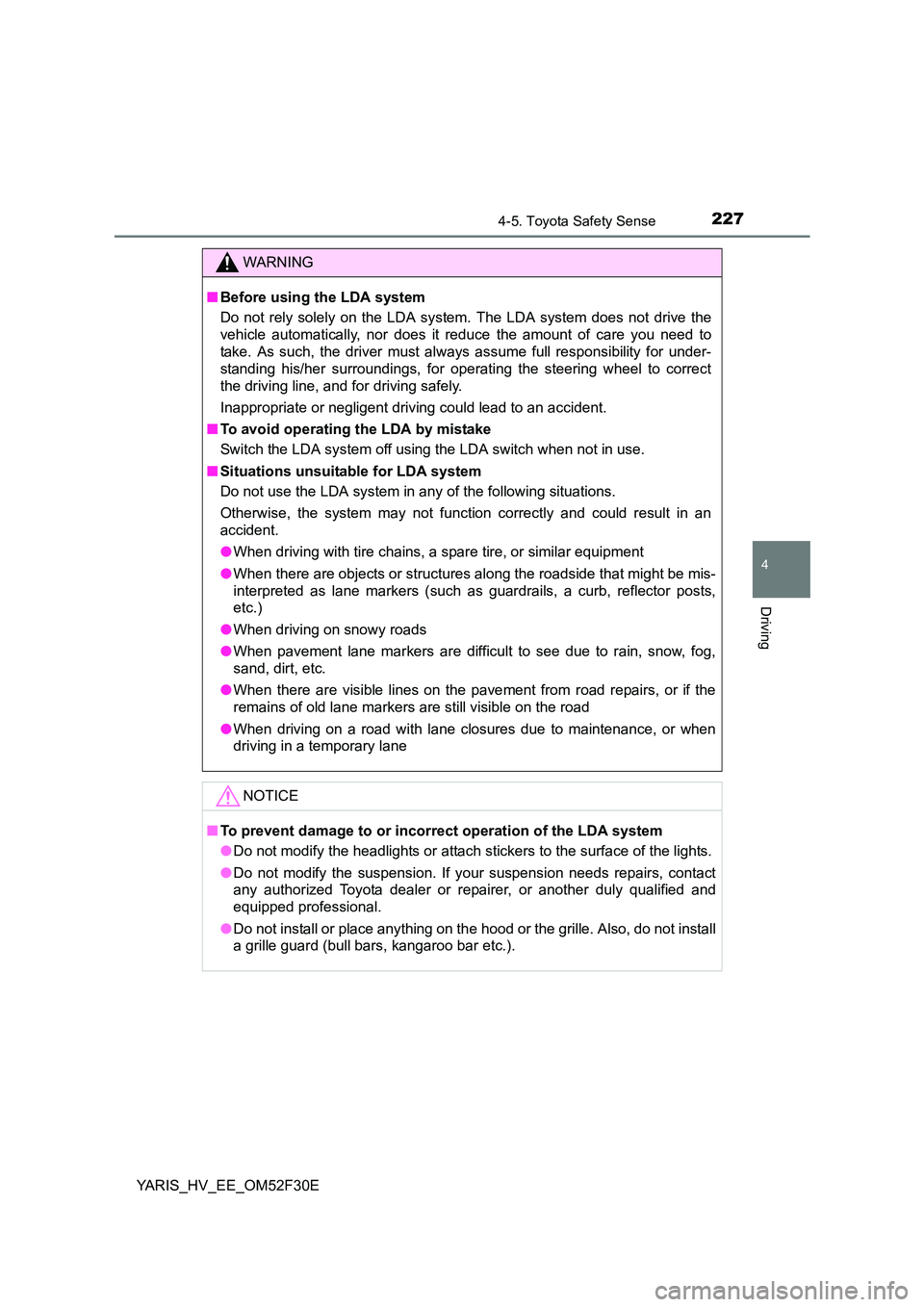
2274-5. Toyota Safety Sense
4
Driving
YARIS_HV_EE_OM52F30E
WARNING
■ Before using the LDA system
Do not rely solely on the LDA system. The LDA system does not drive the
vehicle automatically, nor does it reduce the amount of care you need to
take. As such, the driver must always assume full responsibility for under-
standing his/her surroundings, for operat ing the steering wheel to correct
the driving line, and for driving safely.
Inappropriate or negligent driving could lead to an accident.
■ To avoid operating the LDA by mistake
Switch the LDA system off using the LDA switch when not in use.
■ Situations unsuitable for LDA system
Do not use the LDA system in any of the following situations.
Otherwise, the system may not function correctly and could result in an
accident.
● When driving with tire chains, a spare tire, or similar equipment
● When there are objects or structures along the roadside that might be mis-
interpreted as lane markers (such as guardrails, a curb, reflector posts,
etc.)
● When driving on snowy roads
● When pavement lane markers are difficult to see due to rain, snow, fog,
sand, dirt, etc.
● When there are visible lines on the pavement from road repairs, or if the
remains of old lane markers are still visible on the road
● When driving on a road with lane closures due to maintenance, or when
driving in a temporary lane
NOTICE
■ To prevent damage to or incorrect operation of the LDA system
● Do not modify the headlights or attach stickers to the surface of the lights.
● Do not modify the suspension. If your suspension needs repairs, contact
any authorized Toyota dealer or repairer, or another duly qualified and
equipped professional.
● Do not install or place anything on the hood or the grille. Also, do not install
a grille guard (bull bars, kangaroo bar etc.).
Page 228 of 492
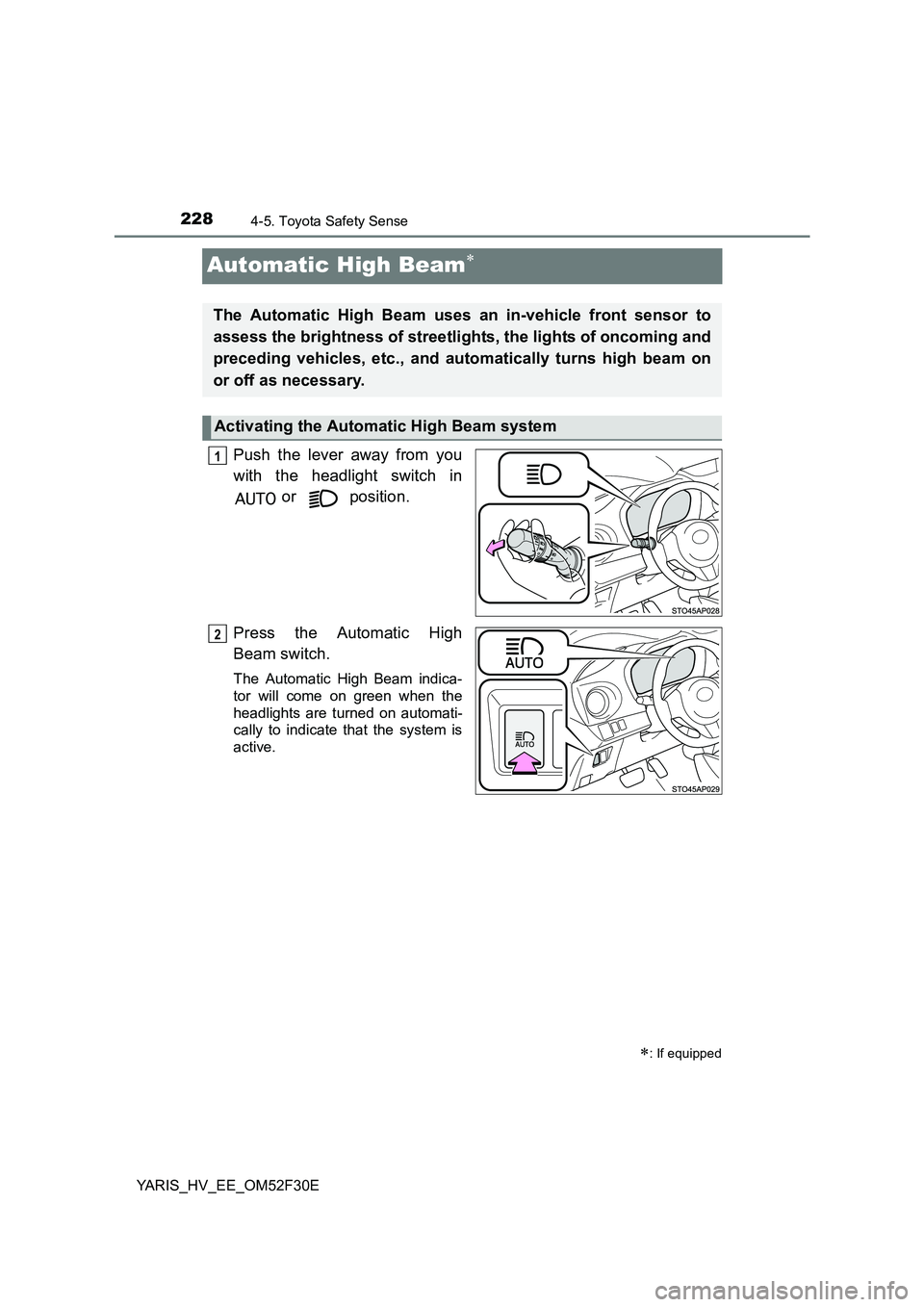
2284-5. Toyota Safety Sense
YARIS_HV_EE_OM52F30E
Automatic High Beam∗
Push the lever away from you
with the headlight switch in
or position.
Press the Automatic High
Beam switch.
The Automatic High Beam indica-
tor will come on green when the
headlights are turned on automati-
cally to indicate that the system is
active.
∗: If equipped
The Automatic High Beam uses an in-vehicle front sensor to
assess the brightness of streetlights, the lights of oncoming and
preceding vehicles, etc., and automatically turns high beam on
or off as necessary.
Activating the Automatic High Beam system
1
2
Page 229 of 492
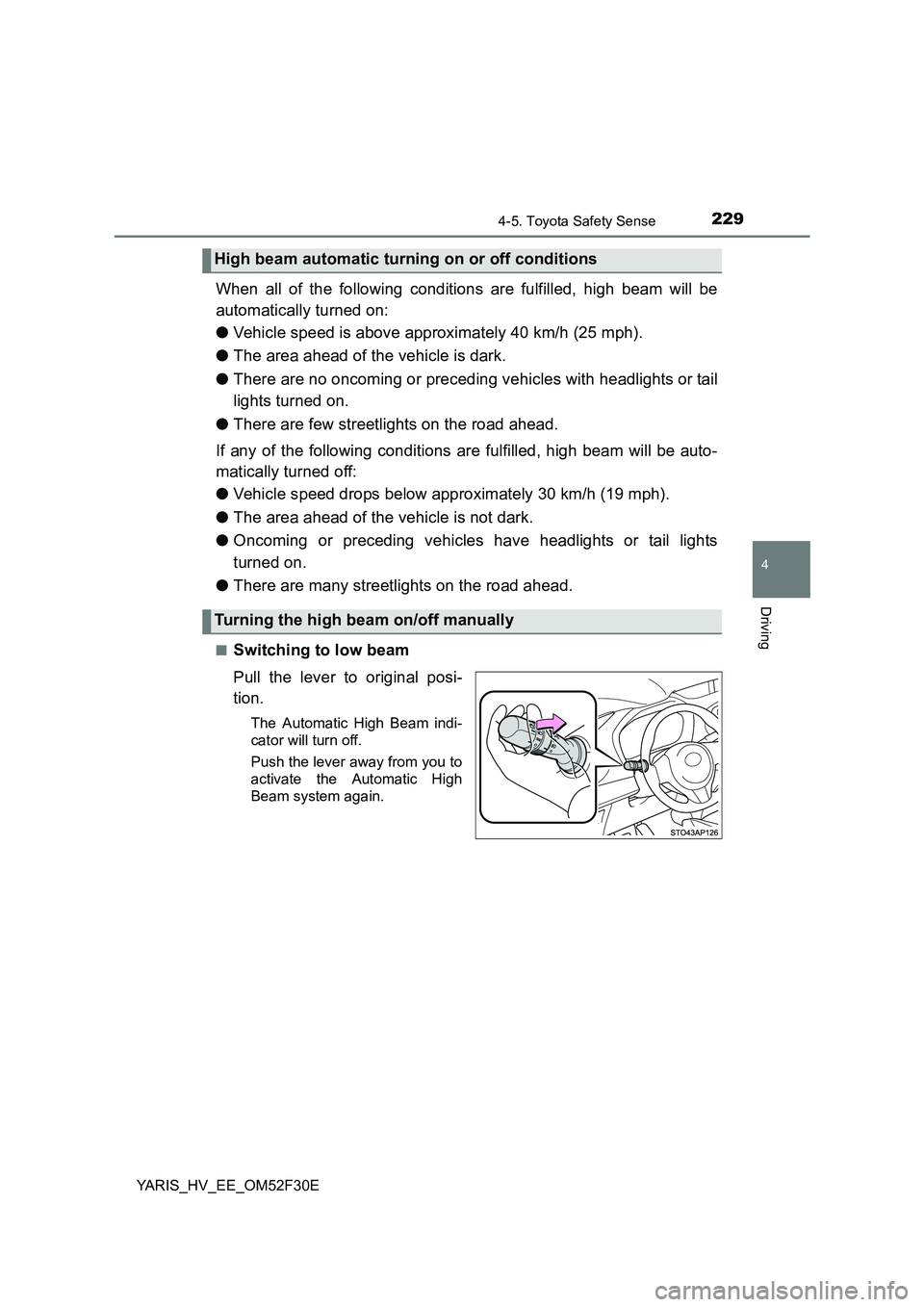
2294-5. Toyota Safety Sense
4
Driving
YARIS_HV_EE_OM52F30E
When all of the following conditions are fulfilled, high beam will be
automatically turned on:
● Vehicle speed is above approximately 40 km/h (25 mph).
● The area ahead of the vehicle is dark.
● There are no oncoming or preceding vehicles with headlights or tail
lights turned on.
● There are few streetlights on the road ahead.
If any of the following conditions are fulfilled, high beam will be auto-
matically turned off:
● Vehicle speed drops below approximately 30 km/h (19 mph).
● The area ahead of the vehicle is not dark.
● Oncoming or preceding vehicles have headlights or tail lights
turned on.
● There are many streetlights on the road ahead.
■Switching to low beam
Pull the lever to original posi-
tion.
The Automatic High Beam indi-
cator will turn off.
Push the lever away from you to
activate the Automatic High
Beam system again.
High beam automatic turning on or off conditions
Turning the high beam on/off manually
Page 230 of 492
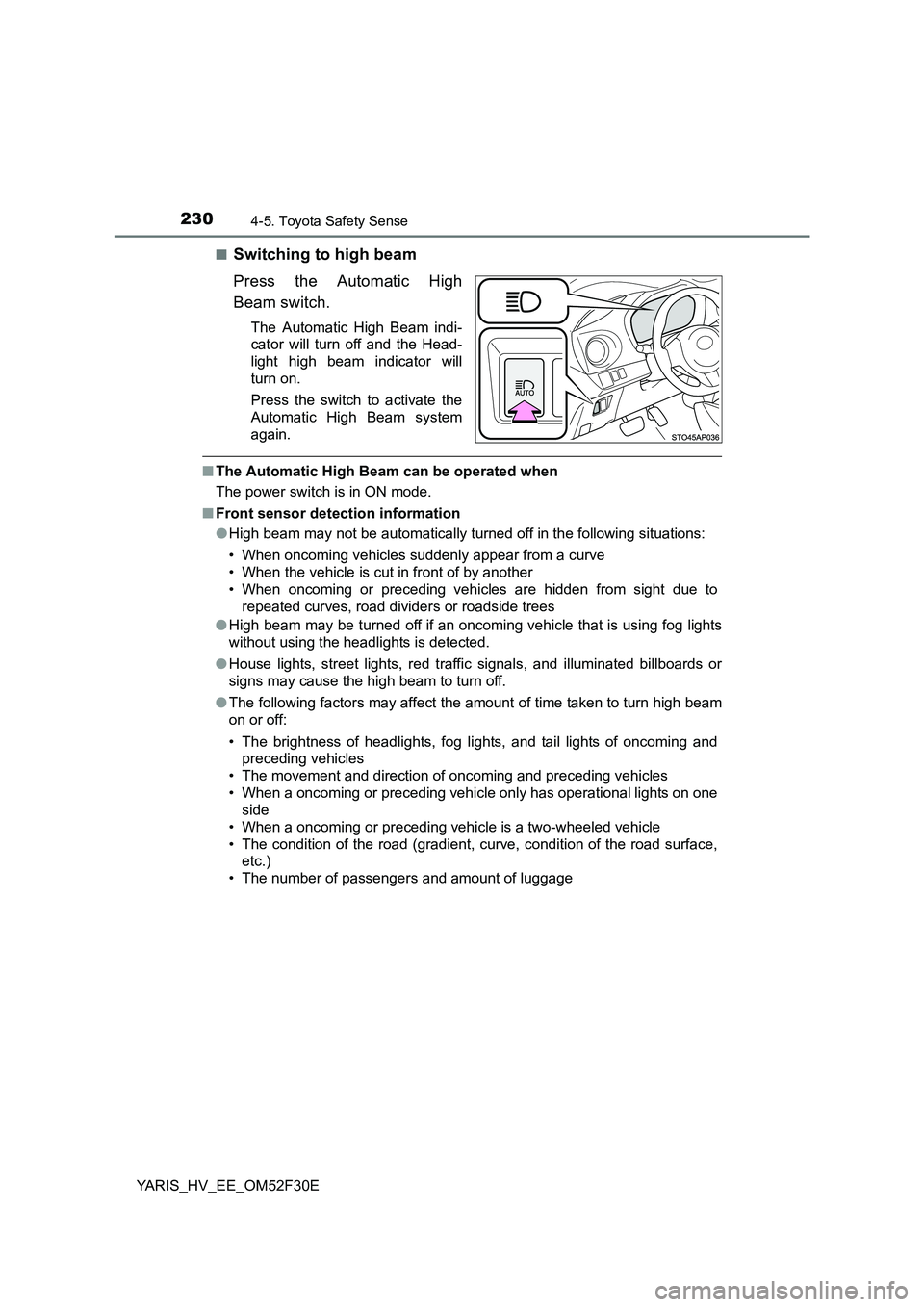
2304-5. Toyota Safety Sense
YARIS_HV_EE_OM52F30E
■Switching to high beam
Press the Automatic High
Beam switch.
The Automatic High Beam indi-
cator will turn off and the Head-
light high beam indicator will
turn on.
Press the switch to activate the
Automatic High Beam system
again.
■ The Automatic High Beam can be operated when
The power switch is in ON mode.
■ Front sensor detection information
● High beam may not be automatically turned off in the following situations:
• When oncoming vehicles suddenly appear from a curve
• When the vehicle is cut in front of by another
• When oncoming or preceding vehicles are hidden from sight due to
repeated curves, road divi ders or roadside trees
● High beam may be turned off if an oncoming vehicle that is using fog lights
without using the headlights is detected.
● House lights, street lights, red traffic signals, and illuminated billboards or
signs may cause the high beam to turn off.
● The following factors may affect the amount of time taken to turn high beam
on or off:
• The brightness of headlights, fog lights, and tail lights of oncoming and
preceding vehicles
• The movement and direction of oncoming and preceding vehicles
• When a oncoming or preceding vehicle only has operational lights on one
side
• When a oncoming or preceding vehi cle is a two-wheeled vehicle
• The condition of the road (gradient, curve, condition of the road surface,
etc.)
• The number of passengers and amount of luggage